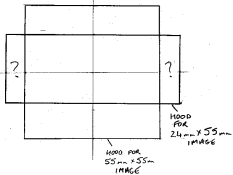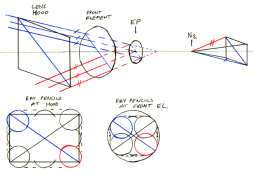And one more for your thoughts, Helen,
- it is not as easy as to say -the format is half, then the shade will be halfed too for the same length of the hood (square or not). As I said already several times, the hood changes its dimension in a non linear way when you change its length. Nor can you assume that if one of the film format's side is constant that it would mean one of the hood side is constant too. The relations are more complicated than that (and in fact in some way also easier...) Anyway... George
George,
If an opening of 88 mm x 88mm is adequate to pass all the image-forming rays heading towards a 55 mm x 55 mm image, why do enlargements (marked with a question mark in the sketch) need to be made to the opening to pass all the rays heading towards a smaller image? What rays pass through these enlargements, and why werent they necessary for the larger image format? I find those questions difficult to answer, and I would appreciate your assistance.
Your assumptions: I wonder whether the relationship between the film format and the diameter of the front element is an implicit assumption, if it is not an explicit one. The results that you have given in this thread appear to suggest that it is. The diameter of the front element need not appear in the image-side calculations for the relationship to exist.
If the front element is relatively close to the entrance pupil, it wont make a lot of difference which one is used for the calculations.
Here is the reasoning behind the classic simple method. I would welcome any comments, especially critical ones. It is a lot easier to draw out step by step than it is to explain, but Ill give it a go.
Purpose: To design a lens hood given only the film format, lens focal length and the diameter of the front element of the lens.
Note: This amount of information is inadequate for designing an optimal lens hood, but it can be used for an approximate design.
Image-side calculation.
Construct a triangle with a base equal to the diagonal of the film format and height equal to the lens focal length. This represents the diagonal field of view of the lens/film, and the apex lies at the rear (second) nodal point of the lens.
That is the full extent of the image-side calculation.
Object-side calculation.
Draw the lens axis, and place the centre of the entrance pupil at some point on the axis. You dont need to know where the entrance pupil is.
Construct a triangle on the axis similar to the image-side one (in practice, this is the same triangle, extended as necessary). This represents the two rays that will pass through the centre of the entrance pupil, then arrive at the corners of the image.
When the lens is focused at infinity these central rays will be surrounded by parallel rays from the same object point that will be focused at the corners of the image. The ray bundles will be bounded by the entrance pupil. (There may also be other restrictions, but these will be ignored for the purposes of this approximate calculation, because they are unknown). Because the peripheral rays in the ray bundles are parallel to the central rays, the angle between the central rays equals the angle between the peripheral rays, and the same two lines can be used to describe the extremities of the ray bundles. The entrance pupil is now at some unknown point along the axis, away from the apex of the triangle.
Because the location of the entrance pupil is unknown, we will have to make the assumption that the rays that graze the edge of the entrance pupil also graze the edge of the front element. This is not necessarily true, but the closer the front element is to the entrance pupil, the less error will be introduced. If the position and diameter of the entrance pupil is known, it can be used in place of the front element, if it is more restricting than the front element. (This can apply if a lens is used for a format smaller than the image circle of the lens, and there is a significant distance between the entrance pupil and the front element).
The diagonal of the lens hood at any point in front of the front element can now be measured or calculated by simple geometry. It need not be done by trigonometry.
The sides of a rectangular or square hood can now be calculated from the diagonal. Note that the bundle of rays heading towards the film will have rounded corners, and squaring those off from the diagonal results in a square or rectangle that is slightly smaller than the ray bundle, but this does not normally matter in practice. The closer the hood is to the entrance pupil, and the wider the aperture, the more this squaring-off will obstruct the peripheral rays.
It is quite possible for a rectangular hood to have a side smaller than the diameter of the front element. In some cases both sides can be shorter than the diameter. If the entrance pupil is used in the calculation, no side of the hood should ever be shorter than the diameter of the entrance pupil.
Best,
Helen




 as suggested in a post. He confirmed my understanding of his method (the length is calculated from the lens vertex). He's now on a foreign travel and will come back to me with more to say - it seems that he gets questions about the lens hood calculation from other people on Apug and helps them but he himself is not a member.
as suggested in a post. He confirmed my understanding of his method (the length is calculated from the lens vertex). He's now on a foreign travel and will come back to me with more to say - it seems that he gets questions about the lens hood calculation from other people on Apug and helps them but he himself is not a member.
